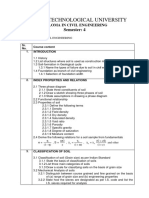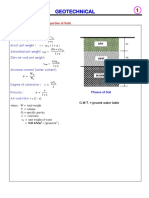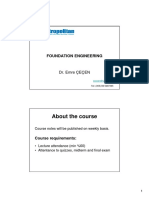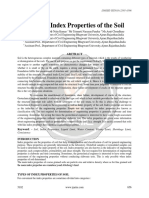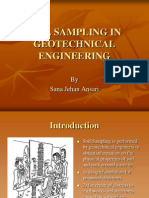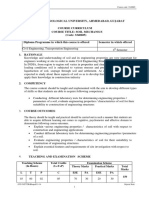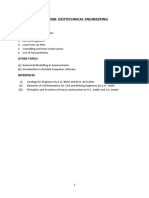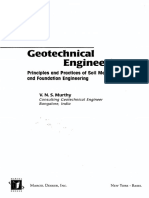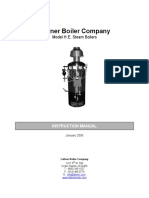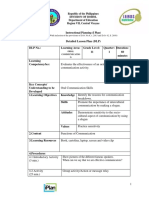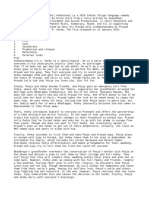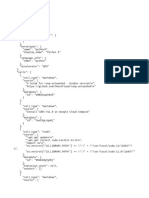1.
Index Properties and classification of soil:-
16 August 2024 15:21
Index properties are essential for assessing the engineering behavior of soil and accurately classifying it. These properties help us
understand how soil responds to various forces and conditions.
Grain-Size Distribution Atterberg's limits Strength and load- Swelling and settlement
Bearing Capacity
i. Determines the proportion of i. Liquid limit (LL):- the moisture i. Coarse-grained soil i. Swelling occurs in
different-sized particles (sand, silt, content at which soil behaves like strength depends on expansive soil (certain
clay) in the soil. a liquid under minimal stress. grain angularity and clays) due to water
ii. Analyzed through sieve analysis. ii. Plastic limit (PL):- the moisture size. absorption.
iii. Coarse-grained soil (sand, gravel) content at which soil becomes ii. Higher angularity leads ii. Settlement refers to soil
focuses on grain shape and size. plastic and can be molded without to greater shearing compression under load.
iv. Fine-grained soil (silts, clays) breaking. strength.
considers Atterberg's limits (liquid iii. Shrinkage limit (SL):-the iii. Load-bearing capacity
limit, plastic limit and shrinkage limit) moisture content which further relates to soil's ability
and consistency. drying causes no volume change. to support structures.
Soil Classification:-
Various classification systems exist based on index properties:
i. Unified Soil Classification systems (USCS): commonly used in geotechnical engineering.
ii. AASHTO Soil Classification System: used for highway construction.
iii. British Soil Classification System: used in UK
iv. Indian Standard Soil Classification System: used in INDIA.
INDIAN STANDARD SOIL CLASSIFICATION SYSTEM:
The ISSCS is widely used in India for classifying soils based on their properties. It considers both grain-size distribution and
consistency. Here are the main categories:-
1. Coarse-Grained Soils:
a. These soils primarily consist of larger particles such as sand and gravel.
They are further divided into:
i. Gravel (G): particles larger than 4.75mm.
ii. Sand (S): particles between 4.75mm and 75 microns. Sand is further classified based on its fines content:
Well- graded (SW, SP): uniform distribution of particles sizes.
Poorly graded (SW, SP): non-uniform distribution.
iii. Silt (M): particles between 75 microns and 2 microns.
iv. Clay ©: particles smaller than 2 microns. Clay is further classified based on its plasticity:
Low Plasticity (CL): low plasticity index (PI).
High plasticity (CH): high PI.
Inorganic (Cl): non-plastic clay.
Organic (OL, OH, Pt): contains organic matter.
2. Fine-Grained Soils:
i. These soils mainly consist of silt and clay.
ii. They are further divided into
Silt (M): particles between 75 microns and 2 microns.
Clay ©: particles smaller than 2 microns.
Similar to coarse-grained soils, clay is classified based on plasticity.
3. Peat (Pt):
i. Organic soil with high water content.
ii. Composed of partially decayed plant material.
2. COMPRESSIBILITY OF SOIL:
Compressibility refers to the property of soil particles being brought closer together due to the escape of air and water from voids
under the influence of applied pressure.
When a soils mass experiences compressive force, its volume decreases, resulting in settlement. Excessive settlements can lead to
structural damage or loss of functionality in buildings and other structures.
i. Coefficient of Compressibility (av):
Represents the rate of change of void ratio € concerning the applied effective pressure (p) during compression.
∆
∆
geotech 1 Page 1
� ∆
av = ⎯⎯
∆
Where e= 0 is the initial void ratio.
e= 1 is the final void ratio.
p= 0 is the initial effective stress.
p= 1 is the final effective stress.
ii Coefficient of Volume Compressibility (mv):
Measures the volume decrease of a unit volume of soil per unit increase in effective pressure during compression.
For a thick soil layer, it can be divided into sub-layers, each with its stress at mid-depth.
∆
mv = ⎯⎯⎯
∆
3. SHEAR STRENGTH OF SOIL:
Shear strength refers to the maximum shear stress that soil can sustain without experiencing failure. It plays a crucial role in
geotechnical engineering, influencing various aspects of design and stability.
When a soil mass is subjected to vertical stress, normal and shear stresses develop on arbitrary planes within the soil. The
shear strength represents the resistance to these shearing stresses and the tendency for shear deformation.
-FACTORS AFFECTING SHEAR STRENGTH :- SHEAR STRENGTH PARAMETERS
i. Normal stress σn i. Cohesion ©:- the shear strength of soil when the normal stress is zero .
Cohesion c 2. Friction angle : the angle between the normal stress and shear stress at
ii.
failure.
iii. Friction angle Φ
iv. Water content
v. Density
vi. Soil structure
SHEAR STRENGTH EQUATIONS :- TYPES OF SHEAR TESTS
i. Coulomb's equation: τ = c + σn × tanΦ Direct shear test (DST)
ii. Mohr-coulomb's equation: τ = c + σn × tanΦ + σt tanΨ Triaxial shear test (TST)
Unconfined compression test (UCT)
SHEAR STRENGTH OF DIFFERENT SOILS:
i. Sands : high friction angle, low cohesion.
ii. Clays : low friction angle , high cohesion.
iii. Silts : intermediate properties.
4. FLOW OF WATER THROUGH SOILS
i. Infiltration:
a. water enters soil surface through soil in a saturated condition.
b. analyzed using Darcy's law and hydraulic head.
c. important for designing dams, foundations, and retaining walls.
ii. Permeability (k):
a. measure of soils ability to transmit water.
b. units: m/s, cm/s, ft/day.
c. depends on soil type, void ratio and degree of saturation.
iii Hydraulic Head:
a. measure of water pressure and elevation.
b. components: elevation head, pressure head and velocity head.
c. used to analyze seepage and flow through soils.
Iv Flow Nets
a. Graphical representation of seepage flow.
b. used to visualized and analyze flow patterns
c. important considerations in design of geotechnical structures.
v. Soil Liquefaction:
a. Loss of soil strength due to increased pore water pressure.
b. can occur during earthquakes or rapid loading.
geotech 1 Page 2
� b. can occur during earthquakes or rapid loading.
c. important consideration in design of foundations and structures.
5. SOIL SURFACE EXPLORATION:
An engineer can design a structure by knowing reasonably well the physical properties and sequence of occurrence of the subsoils. The
field and laboratory investigations required to obtain the above information are called soil exploration.
Purpose of soil exploration:
a. To determine the properties of soil and ground water which affect the design and safety of structures.
b. To determine the extent and properties of the material to be used for various engineering construction.
c. To determine the sequence, thickness, the level of bed rock and lateral extent of the soil strata.
d. To obtain disturbed and undisturbed samples for identification and laboratory testing.
e. To carry out fields tests to know about the insitu soil properties.
Depth of exploration:- depends upon
a. Type of structure, its size, shape and weight.
b. Load coming on foundation.
c. Soil profile and its properties.
d. Design consideration such as safety against foundation failure, excessive settlement, seepage failure, earth pressure etc.
e. Depth of exploration different for various types of foundations and structures.
Methods of exploration Open Excavations
a. Open excavations i. Test Pits
b. Borings Ii. Test Trenches
c. Geophysical methods Iii. Open Borings
d. Sounding and Penetration.
BORINGS:
Boring are generally used for depths greater than 3 m or when difficult ground water conditions are met. The diameter of bore hole
generally varies from 50 mm to 250 mm depending on the type of investigation, size of required samples and the type of available
equipment.
a. Auger Boring
b. Wash Boring
c. Percussion Drilling
d. Rotary Drilling
STANDARD PENETRATION TEST: SPT is used for determining
i. Angle of shearing resistance.
ii. Density index
iii. Ultimate load carrying capacity based on settlement and shear criteria.
iv. Procedure
a. A split span sampler is driven inside the soil by driving mechanism of hammer.
b. The bore hole is done until the test level and test is repeated at every change of 3.5m interval.
c. Wt of hammer 63.5kg.
d. Ht of hammer 75cm.
e. Due to per blow of hammer, penetration observed is refered as set.
f. The test is done in 3 stages, in each stage 150mm penetration is observed.
g. The SPT num is taken as no of blows corresponding to least 300mm penetration.
h. The no of blows corresponding to first 150mm penetration is neglected on the sampler may not be in proper contact
with the surface.
i. OVERBURDEN CORRECTION:
𝟑𝟓𝟎
N1 = N×⎯⎯⎯⎯⎯
𝛔 𝟕𝟎
j. WATER TABLE CORRECTION:
N2 = 15 + 0.5(N1 - 15) if N1 > 15
If N1 < 15 N2 = N1
v. PECK'S HAMEN'S EQUATION
𝐳
Qu = 0.41 NCwS ⎯⎯⎯⎯)
Cw = 0.5 (1 + 𝐃𝐟 𝐁
N = corrected SPT no
geotech 1 Page 3
� N = corrected SPT no
Cw = water table correction
S = allowable settlement (mm)
6. BEARING CAPACITY THEORY
Bearing capacity theory deals with the ability of soil to support the load from a structure without undergoing shear failure. The
theory is crucial for designing safe and stable foundations.
1. Basic Concepts:
i. Ultimate Bearing Capacity (qult): The maximum pressure that can be applied to the soil at the foundation base before it fails
in shear.
2. Allowable Bearing Capacity (qallow): The maximum pressure that can be safely applied, accounting for a safety factor
(SF). It is given by:
qallow = qult / SF
2. Terzaghi's Bearing Capacity Theory
Karl Terzaghi's theory is the cornerstone of modern bearing capacity calculations. He derived an equation to estimate the ultimate
bearing capacity of shallow foundations on homogenous soils. The general form of terzaghi's equations is:
Qult = c′Nc + γDfNq + 0.5γBNγ
Where:
i. c': effective cohesion of soil (kN / m2)
ii. y: unit weight of soil (kN / m3)
iii. Df: depth of foundation (m)
iv. B: width of foundation (m)
v. Nc, Nq, Ny : bearing capacity factors, which depend on the internal friction angle ϕ′ of the soil.
3. Bearing Capacity factors:
The factors Nc, Nq, Ny are dimensionless and depend on the soil's angle of internal friction ϕ.
Nq= 0.5 {eπtanϕ′⋅tan2(45∘+2ϕ′)}
Nc = (Nq - 1) / tanꟀ
Nγ= 2(Nq+1)⋅tanϕ′/ (1+0.4sin(4ϕ′))
4. Meyerhof's Bearing Capacity Theory:
Meyerhof extended terzaghi's theory to account for different shapes and inclinations of foundations, along with
factors such as depth and load inclination.
qult = c′Ncscdcic + γDfNqsqdqiq + 0.5γBNγsydyiy
Where:
i. sc , sq , sy : shape factors
ii. dc , dq , dy : depth factors
iii. ic , iq , iy : inclination factors.
5. Factors Affecting Bearing Capacity
i. Soil type : Cohesive soils like clay have different bearing capacities than granular soils like sand.
ii. Water Table : The presence of groundwater can reduce the bearing capacity by lowering the effective stress
in the soil.
iii. Foundation Depth: Increasing the depth generally increases the bearing capacity, as it mobilizes stronger soil
layers.
iv. Load Inclination : Inclined loads reduce the effective bearing capacity, as they tend to cause shear along the
foundation base.
geotech 1 Page 4
� foundation base.
7. METHODS OF DETERMINING THE EARTH LATERAL PRESSURE
1. Rankine's Earth pressure theory:
For Active Earth Pressure (Pa):
i. Occurs when the wall moves away from the soil, causing the soil to expand
Pa = 1/2 yH2Ka Ka = tan2 (45o - Ꟁ/2)
Where
a. Pa = active earth pressure per unit length of the wall
b. y = unit weight of the soil
c. H = height of the wall
d. Ka = coefficient of active earth pressure.
e. Ꟁ = angle of internal friction of the soil.
For Passive Earth Pressure (Pp):
i. Occurs when the wall moves into the soil, causing the soil to compress.
Pp = 1/2 yH2Kp Kp = tan2 (45o + Ꟁ/2)
Where
a. Pp = Passive earth pressure per unit length of the wall.
b. Kp = coefficient of passive earth pressure
2. Coulomb's Earth Pressure Theory:
geotech 1 Page 5
� For Active Earth Pressure (Pa) :
i. Accounts for wall friction and inclined backfill.
Pa = 1/2 yH2Ka
𝒄𝒐𝒔 (𝚹 Ꟁ ) 𝒄𝒐𝒔𝟐 𝚹 𝒄𝒐𝒔 ( Ꟁ )
Ka = ⎯⎯⎯⎯⎯⎯⎯⎯⎯⎯⎯ × ⎯⎯⎯⎯⎯⎯⎯⎯⎯⎯⎯⎯⎯⎯⎯
𝒄𝒐𝒔𝚹 𝒄𝒐𝒔 ( 𝚹) 𝒄𝒐𝒔 ( 𝚹)𝒄𝒐𝒔 (𝚹 Ꟁ)
Where
ϴ = inclination of the backfill with the horizontal.
Ꟁ = angle of wall friction.
For Passive Earth Pressure (Pp):
Pp = 1/2 yH2Kp
𝒄𝒐𝒔 (𝚹 Ꟁ ) 𝒄𝒐𝒔𝟐 𝚹 𝒄𝒐𝒔 ( Ꟁ)
Ka = ⎯⎯⎯⎯⎯⎯⎯⎯⎯⎯⎯ × ⎯⎯⎯⎯⎯⎯⎯⎯⎯⎯⎯⎯⎯⎯⎯
𝒄𝒐𝒔𝚹 𝒄𝒐𝒔 ( 𝚹) 𝒄𝒐𝒔 ( 𝚹 )𝒄𝒐𝒔 (𝚹 Ꟁ)
3. At-Rest Earth Pressure (Ko)
Occurs when the wall does not move.
Ko = 1 - sinꟀ
Lateral earth pressure at rest can be calculated using:
Po = KoyH
8. METHODS OF SLOPE STABILITY
1. The Infinite Slope Method
a. Applicable for : shallow, infinite slopes with a planar failure surface parallel to the slope.
b. Assumptions: The slope is long, uniform, and the failure occurs parallel to the slope surface.
𝐜 𝐲𝐜𝐨𝐬 𝟐 𝛃 𝐲𝐰 𝐭𝐚𝐧 Ꟁ
FoS =⎯⎯⎯⎯⎯⎯⎯⎯⎯⎯⎯⎯⎯⎯⎯⎯
𝐲𝐬𝐢𝐧𝛃𝐜𝒐𝒔𝜷
Where
geotech 1 Page 6
� Where
c' = effective cohesion of the soil
y = unit weight of the soil
yw = unit weight of water (if the slope is partially saturated)
𝛽 = slope angle
Ꟁ = effective angle of internal friction of the soil.
2. The Swedish Circle (Fellenius) Method
Applicable for: Circular slip surfaces, commonly used for homogeneous slopes.
Assumptions: Circular failure surface, the method is simple and conservative.
∑(𝐜⋅𝐛 (𝐖𝐜𝐨𝐬𝛂)𝐭𝐚𝐧𝛟)
FoS = ⎯⎯⎯⎯⎯⎯⎯⎯⎯⎯⎯⎯⎯⎯
∑(𝐖𝐬𝐢𝐧𝛂)
Where
c = cohesion of the soil.
b = width of the slice (in the direction of sliding)
W = weight of the soil slice
α = angle of the base of the slice with the horizontal
𝛟 = angle of internal friction
3. The Bishop's Simplified Method
Applicable for: Circular slip surfaces, more accurate than the Fellenius method.
Assumptions: Slices are assumed and moment equilibrium is considered, but side forces are neglected.
𝒘 𝒖
∑[(𝒄 𝒃 ⎯⎯⎯ 𝐭𝐚𝐧 𝛟 ) 𝐜𝐨𝐬 𝛂
FoS = ⎯⎯⎯⎯⎯⎯⎯⎯⎯⎯⎯⎯⎯⎯⎯⎯⎯⎯
∑ 𝑾𝒔𝒊𝒏 𝛂
𝑭𝒐𝒔
where u = pore water pressure force on the base of the slice.
geotech 1 Page 7














